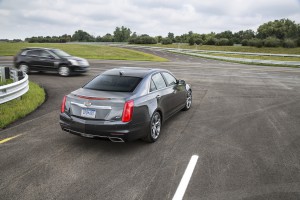
By 2017, the Cadillac CTS will be equipped with V2V technology. Might that technology not only improve safety, but also save fuel?
Adding autonomous driving and vehicle-to-vehicle communication capability is expected to make driving safer and shorten commuting times.
But now the University of Michigan and the Argonne National Laboratories outside of Chicago and Idaho National Laboratory are teaming up to see if the V2V technology also can help motorists save fuel.
The university and two U.S. Department of Energy (DOE) national laboratories plan to collaborate on a study to determine if connected and automated vehicles could help people drive more efficiently.
Reuben Sarkar, DOE deputy assistant secretary for transportation, announced the department will finance the research through a $2.7 million grant that he described as an “incubator award” to help DOE learn more about connected and automated vehicles, which are a growing focus for the agency.
“I want to congratulate the University of Michigan as the recipient of our incubator award, in partnership with Argonne National Lab and Idaho National Lab, to help us study the energy impact of connected and automated vehicles by taking advantage of U-M’s 500-vehicle fleet,” Sarkar said.
U-M’s team of researchers is drawn from the U-M Mobility Transformation Center, U-M Transportation Research Institute and College of Engineering. “Nobody knows the magnitude of what the energy savings of connected and automated vehicles will be,” said MTC Director Peter Sweatman. “We’re going to actively collect the data to do that.”
U-M will recruit 500 volunteers in the Ann Arbor area to participate in the project. Their personal vehicles will be equipped to collect energy consumption data, in addition to information about vehicle motion, such as speed and location, as the volunteers go about their daily routines. Some of the vehicles could belong to fleet or commercial users.
The project also plans to study how drivers react to various functions in connected and automated vehicles, and whether any resulting change in behavior affects energy consumption.
(Mitsubishi unveils new Outlander Sport, Mirage. For more, Click Here.)
“Reducing emissions and saving fuel are expected to be significant benefits once connected and automated vehicles are on the road in large numbers,” said Huei Peng, MTC associate director and a principal investigator on the DOE project.
“Unlike the safety impact of these vehicles, however, energy consumption has not been widely studied. This research will help us better understand the potential energy savings and identify possible obstacles to achieving meaningful reductions.”
The majority of vehicles in the study will be hybrid-electric vehicles, plug-in hybrid-electric vehicles and battery electric vehicles, with only a small number expected to be traditional cars or trucks. Peng said there is a clear relationship between vehicle motion and energy consumption in conventional vehicles, but that relationship can vary widely in hybrid-electric and plug-in vehicles.
Argonne will contribute modeling and simulation expertise in transportation system and vehicle energy consumption, as well as development of a display module to better understand drivers’ behaviors.
(Click Here for details Subaru’s new thinly disguised Impreza.)
Argonne’s Autonomie vehicle system modeling tool is widely used by manufacturers and researchers to virtually investigate the impact of various technologies on efficiency. The project also will use Argonne’s POLARIS system, an open-source high-speed computing framework for traffic flow and transportation system modeling.
By combining the vehicle motion and energy consumption data generated by U-M’s 500-vehicle fleet with Argonne’s modeling and simulation capabilities, new insights will be generated into the energy impact of connected vehicles that can communicate with the world around them.
“This is a unique opportunity to leverage the knowledge and experience of three world-class institutions to understand the energy impact of connected and automated vehicles,” said Aymeric Rousseau, manager of the Systems Modeling and Simulation Section at Argonne. “Argonne is pleased to be a part of this effort, which will be important to paving the way to future transportation systems.”
Idaho National Laboratory will consult on the project to provide guidance about data collection and analysis. The laboratory recently led a nationwide study to analyze energy usage and driver charging behavior for approximately 8,300 plug-in electric vehicles and 125 million driving miles.
(To see more about expectations of another U.S. auto sales record in 2017, Click Here.)
“We’re eager to share insights we gained from our experience collecting and analyzing energy data from vehicles in real-world driving situations around the country,” said John Smart, INL’s Advanced Vehicles Group Lead. “We are eager to partner with U-M and Argonne in this exciting project.”

Simply synchronizing traffic signals could reduce traffic jams, commute times and fuel consumption but most municipalities refuse to do this.
AVs may or may not improve the situation depending on how they are programmed and how smart the programming is in making the correct choices at any given time when in operation. If you’ve ever seen a NAV system that directs you to take a side street off of a main highway and then brings you back on the main hwy. a 1/4 mile later because the side street is technically 20 ft. shorter than staying on the main hwy., then you have seen poor software logic in action as the time lost using the side street adventure increases commute time, driver frustration and fuel consumption.